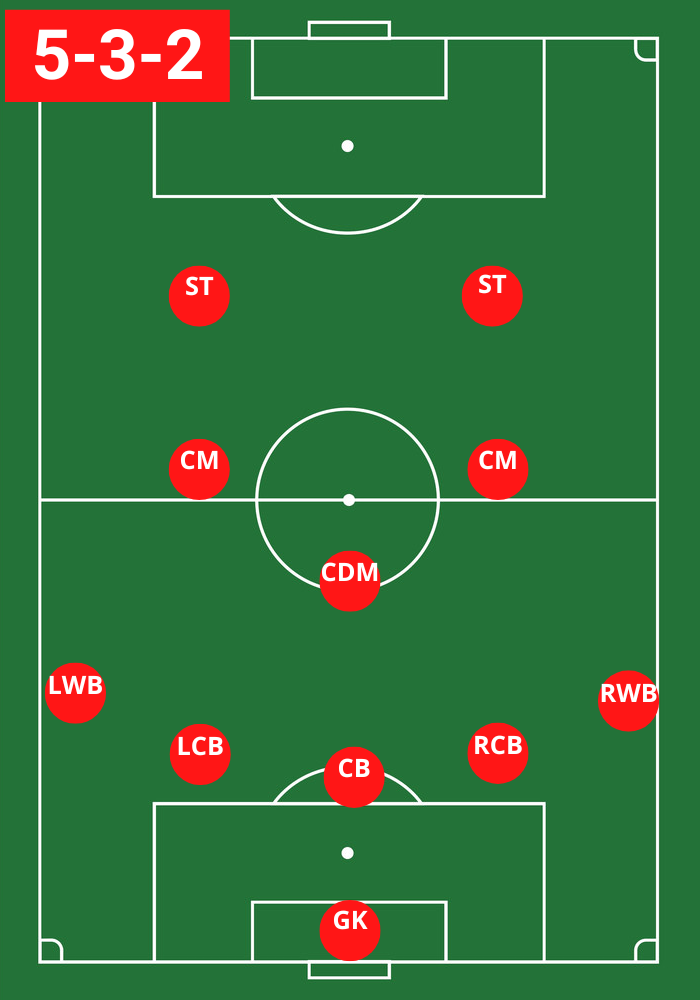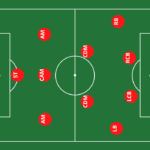Discover the best 5-3-2 Soccer Formation
- Last Updated -
5-3-2 Formation
Are you a soccer enthusiast looking to understand the tactical intricacies that shape a team’s gameplay? If so, you won’t want to miss this article on the 5-3-2 formation. This formation has garnered attention for its unique approach to defensive play and counterattacking potential.
Join us as we delve into the history and tactics of the 5-3-2 formation, exploring its strengths, weaknesses, and relevance in modern football. Get ready to discover the fascinating world of the 5-3-2 formation and understand how it has evolved over time.
Evolution of Formations in Soccer
Formations in soccer have come a long way since the early days of the sport. Teams have been using different tactical setups for over a century, with the goal of improving their gameplay and gaining an advantage over their opponents. Back in the day, formations like the 2-3-5 pyramid were all the rage, with a primary focus on scoring goals.
As soccer evolved, so did the formations, with teams opting for more defensive setups like the 4-4-2 and 3-5-2. These formations provided a more balanced approach to the game, allowing teams to focus on both attacking and defending. Today, soccer formations continue to evolve, with coaches and teams constantly exploring new strategies to gain an edge on the field.

What is the 5-3-2 Formation?
The 5-3-2 formation, also known as the “three at the back” formation, is a popular tactical setup in soccer. This formation is made up of five defenders, three midfielders, and two forwards. The primary goal of this formation is to create a solid defensive structure while keeping a compact shape on the field. With five defenders and three midfielders, this formation provides excellent defensive cover, making it hard for the opposing team to score.
The two forwards are responsible for scoring goals and creating attacking opportunities. This formation can be highly effective on the counterattack, with the team utilizing the 5-3-2 formation exploiting spaces left by the opposition, launching quick and incisive counterattacks.
With three central midfielders, this formation creates numerous passing options on the field, allowing for increased connectivity and fluidity in the team’s build-up play. Overall, the 5-3-2 formation is a well-rounded tactical setup that can provide both defensive solidity and attacking potential.
Historical Background of the 5-3-2 soccer formation
The 5-3-2 formation has a rich and fascinating history in soccer. The formation’s roots can be traced back to the early 2000s when it was a popular choice for international high-intensity matches. However, as soccer evolved and became more attack-minded, the 5-3-2 formation lost some of its popularity.
Despite this, certain teams continued to use the formation, adapting it to suit their playing style and strengths. The 5-3-2 formation has proven to be an effective tactical setup for teams looking to prioritize defensive solidity while maintaining attacking potential. With five defenders and three midfielders, the formation provides excellent defensive cover, making it hard for the opposing team to score.
One of the most notable aspects of the 5-3-2 formation is its counterattacking potential. With the team exploiting spaces left by the opposition, the 5-3-2 formation can launch quick and incisive counterattacks. This can catch the opposing team off guard and create scoring opportunities for the team using the 5-3-2 formation.
Another advantage of the 5-3-2 formation is its ability to create numerous passing options on the field. With three central midfielders, there is increased connectivity and fluidity in the team’s build-up play, allowing for more creative attacking opportunities.
Overall, the 5-3-2 formation has evolved over time, adapting to the changing dynamics of soccer. While it may not be as widely used as some other formations, it offers strengths in terms of defensive solidity, counterattacking potential, and passing options.
Coaches and teams continue to explore and experiment with formations to find the right fit for their strategies and objectives. The 5-3-2 formation is a testament to how soccer formations can evolve and adapt to meet the needs of teams in different eras.
Strengths of the 5-3-2 Formation
The 5-3-2 formation is an attractive choice for teams looking to prioritize defensive solidity and counterattacking opportunities. This formation has several notable strengths that make it an effective tactical setup. Firstly, with five defenders and three midfielders that can support the defense, the 5-3-2 formation provides a robust defensive structure that is challenging to break down. This solid defense can help a team maintain a clean sheet and prevent the opposition from scoring.
Another strength of the 5-3-2 formation is its counterattacking potential. As the opposition commits men forward to break through the defensive line, the team utilizing the 5-3-2 formation can exploit the spaces left behind, launching quick and incisive counterattacks. This can catch the opposing team off guard and create scoring opportunities for the team using the 5-3-2 formation.
The formation’s structure also creates numerous passing options on the field, making it easier for players to connect with each other and maintain possession of the ball. With three central midfielders, there is increased connectivity and fluidity in the team’s build-up play, allowing for more creative attacking opportunities.
Overall, the 5-3-2 formation is a well-rounded tactical setup that offers strengths in both defense and attack. It can be an effective choice for teams looking to prioritize defensive solidity while also maintaining attacking potential.

Weaknesses of the 5-3-2 Formation
Like any formation, the 5-3-2 has its inherent weaknesses that teams must consider. While this formation boasts strengths, it also comes with some notable weaknesses that can impact gameplay. One of the most significant weaknesses is the lack of width.
The formation relies heavily on wing-backs, meaning that there is only one set of wide players. This can make it challenging to stretch the opposition’s defense and create opportunities from the flanks, leading to a more predictable attacking strategy.
Another weakness of the 5-3-2 formation is the fitness requirements for wing-backs. Wing-backs play a crucial role in this formation, providing both defensive cover and attacking contributions.
This demands a high level of fitness from the wing-backs to constantly sprint up and down the flanks throughout the game. If the wing-backs become fatigued, it can compromise the team’s defensive and attacking capabilities.
The limited attacking options are another weakness of the 5-3-2 formation. With only two dedicated forwards, the midfielders may be positioned farther from the attacking line, potentially leaving the strikers isolated and without sufficient support. This can limit the team’s attacking potential and make it more challenging to score goals.
In conclusion, while the 5-3-2 formation offers strengths in defense and counterattacking potential, it also comes with weaknesses that teams must consider.
The lack of width, fitness requirements for wing-backs, and limited attacking options are all factors that can impact gameplay. Teams must weigh these pros and cons when deciding whether to use the 5-3-2 formation and adapt their tactics accordingly.
Famous Teams and Coaches Embracing the 5-3-2 Formation
The 5-3-2 formation may not be as widely used as some other formations, but it still has its fans in the soccer world. Some notable teams and coaches have embraced this formation and used it to great effect. One such example is Newcastle United, who employed the 5-3-2 formation during the 2019-2020 Premier League season.
Under coach, Steve Bruce, Newcastle United’s implementation of the 5-3-2 formation contributed to their defensive solidity and helped them secure a respectable finish. The team’s defensive record was impressive, with only 58 goals conceded over the course of the season. The 5-3-2 formation allowed Newcastle to maintain a compact shape on the field, making it difficult for opponents to break through their defense.
Another famous team that has used the 5-3-2 formation is Italy’s national team. The formation played a significant role in their successful campaign in the 2020 European Championships. Under coach Roberto Mancini, Italy’s implementation of the 5-3-2 formation provided them with a solid defensive structure and allowed them to launch quick counterattacks. The team’s performances were impressive, culminating in a victory over England in the final.
In conclusion, while the 5-3-2 formation may not be as prevalent as some other formations, certain teams and coaches continue to use it with success. Newcastle United and Italy’s national team are just two examples of teams that have embraced this formation and used it to great effect. As soccer continues to evolve,
it will be interesting to see if more teams and coaches choose to adopt the 5-3-2 formation or other tactical setups.
FAQs
Is the 5-3-2 formation suitable for all teams?
- The 5-3-2 formation may not be suitable for all teams, as it requires specific player attributes and tactical understanding. It is primarily favored by teams looking for defensive solidity and counterattacking opportunities.
Can the 5-3-2 formation be effective in attack as well?
While the 5-3-2 formation is often associated with defensive play, it can be adapted to have attacking potential. With strategic positioning and movement, the wing-backs can provide width and support the two forwards, creating attacking opportunities.
Which teams have successfully used the 5-3-2 formation?
Aside from Newcastle United, other teams have also employed the 5-3-2 formation with success. Italy famously used this formation during the 2006 World Cup, which they won. Other teams that have utilized the 5-3-2 formation include Juventus, Atletico Madrid, and Chelsea.
Are there any variations of the 5-3-2 formation?
Yes, coaches often adapt the 5-3-2 formation to suit their team’s specific tactics and player strengths. Variations can include positional adjustments, player roles, and movements within the formation, offering tactical flexibility.
Can the 5-3-2 formation be vulnerable to teams with wide attacking play?
Due to the formation’s limited width, teams with strong wide attacking players can exploit the spaces on the flanks. This puts more defensive responsibility on the wing-backs and requires cohesive defensive organization from the entire team.
Conclusion
In conclusion, the 5-3-2 formation brings a defensive-minded approach to soccer tactics. Although it may not enjoy the same widespread usage as other formations, it boasts strengths in terms of defensive solidity, counterattacking potential, and passing options. However, it’s important to note that the 5-3-2 formation also has its weaknesses, including limited width and potential attacking limitations.
The formation’s history reflects its evolution and adaptation to the ever-changing landscape of the game.
It’s crucial to understand that the effectiveness of the 5-3-2 formation relies on several factors, such as the team’s playing style, the attributes of the players, and the opposition they face. Coaches and teams consistently explore and experiment with different formations in order to discover the best fit for their strategies and objectives.
Whether you are a coach, player, or avid soccer enthusiast, delving into the intricacies of various formations adds depth and appreciation to the beautiful game. Remember, soccer formations are not rigid rules, but rather dynamic blueprints that can be customized to suit a team’s strengths and style of play.
By constantly seeking to understand and adapt formations, we can enhance our enjoyment and comprehension of soccer. So let’s continue to embrace the artistry and strategic complexity that soccer formations bring to the game.
not rigid rules but rather tactical blueprints that can be adapted and customized to suit the strengths and style of a team.
As we continue to celebrate the ever-evolving nature of soccer, let us take a moment to reflect on the rich history and tactical intricacies of formations. Who knows what new formations will emerge in the future? The possibilities are endless, and that is what makes soccer such a fascinating sport. (1)
How To Break In Soccer Cleats
How to break in soccer cleats The Importance of Breaking in Soccer...
Read MoreHow To Be A Good Soccer Parent! A Guide to Sideline Etiquette
What Makes A Good Soccer Parent? As a soccer parent, you have...
Read MoreWhat is a clean sheet in soccer?
The Importance of Keeping a Clean Sheet: An Introduction to Soccer's Most...
Read MoreWhat is a soccer penalty kick?
Soccer, also known as football, is one of the most popular sports...
Read MoreBest Cheap Soccer Cleats 2024
What are the best soccer cleats? Soccer is a game that requires...
Read MoreSoccer Tips: The Secret to Becoming a Better Player
Soccer is a sport that has become incredibly popular all around the...
Read MoreWhat is the hardest position in soccer to play?
What is The Hardest Position in Soccer Importance of understanding positions in...
Read MoreWhat is a Soccer Assist?
The Importance of Teamwork in Soccer The importance of teamwork in soccer...
Read MoreBest Goalkeeper Gloves 2024
What are the best goalkeeper gloves? When it comes to soccer equipment,...
Read MoreUnderstanding the 4-5-1 Soccer Formation
The Importance of Understanding the Formation Soccer is a tactical sport, and...
Read MoreWhat is the best soccer position to play?
What is the best soccer position? Soccer is a sport that requires...
Read MoreWhat is Soccer Relegation?
Introduction: Exploring the World of Soccer relegation Soccer is one of the...
Read MoreWhat is a cap in soccer?
If you're a soccer fan, you've probably heard the term "cap" being...
Read MoreSoccer vs Football Field – A Tale of Two Fields
Comparing the Corners: Soccer Field Vs Football Field Shapes Let's talk a...
Read MoreBest Indoor Soccer Shoes 2024
Indoor soccer has been gaining popularity over the years, with more and...
Read MoreHandball Rule In Soccer – Law #12
Soccer is one of the most popular sports globally, with millions of...
Read Moresoccer position numbers quick guide
Each player on the field has an important job as it relates...
Read MoreSoccer Substitution Rules: The Strategic Art of Changing the Game
Soccer, known as the beautiful game worldwide, has seen various changes to...
Read MoreDominate the Field With The 4-2-3-1 Soccer Formation
Soccer is a dynamic game that constantly evolves, and its tactics are...
Read MoreSoccer History USA: From Struggles to Successes
Soccer, also known as football, is the world's most popular sport, with...
Read More


















